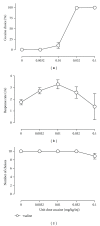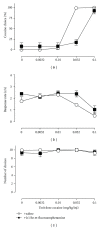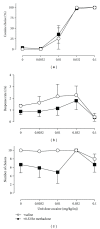Preclinical Determinants of Drug Choice under Concurrent Schedules of Drug Self-Administration - PubMed (original) (raw)
Preclinical Determinants of Drug Choice under Concurrent Schedules of Drug Self-Administration
Matthew L Banks et al. Adv Pharmacol Sci. 2012.
Abstract
Drug self-administration procedures have played a critical role in the experimental analysis of psychoactive compounds, such as cocaine, for over 50 years. While there are numerous permutations of this procedure, this paper will specifically focus on choice procedures using concurrent schedules of intravenous drug self-administration. The aims of this paper are to first highlight the evolution of drug choice procedures and then review the subsequent preclinical body of literature utilizing these choice procedures to understand the environmental, pharmacological, and biological determinants of the reinforcing stimulus effects of drugs. A main rationale for this paper is our proposition that choice schedules are underutilized in investigating the reinforcing effects of drugs in assays of drug self-administration. Moreover, we will conclude with potential future directions and unexplored scientific space for the use of drug choice procedures.
Figures
Figure 1
Baseline choice between different doses of cocaine (0–0.1 mg/kg/injection) and food pellets in rhesus monkeys (n = 4) under a concurrent FR10 : FR100 schedule of cocaine injections and food availability. Abscissae: unit dose of cocaine in milligrams per kilogram per injection. Top ordinate: percent cocaine choice. Middle ordinate: rates of responding in responses per second. Bottom ordinate: number of choices completed. All points represent mean data SEM obtained during the last 3 days of saline treatment. These unpublished data demonstrate two key observations from choice procedures. First, cocaine choice increases in a monotonic function as the unit cocaine dose increases. Second, while rates of responding display the prototypic, inverted-U-shaped dose-effect function, rates of responding are not predictive of cocaine choice, nor are rates of responding predictive of the number of choices completed per component.
Figure 2
Effects of chronic intravenous _m_-fluoroamphetamine (0.1 mg/kg/hr) administration on choice between cocaine and food in rhesus monkeys (n = 4). Abscissae: unit dose of cocaine in milligrams per kilogram per injection. Top ordinate: percent cocaine choice. Middle ordinate: rates of responding in responses per second. Bottom ordinate: number of choices completed. All points represent mean data SEM obtained during the last 3 days of _m_-fluoroamphetamine treatment. These published data [17] demonstrate that experimental manipulations can selectively decrease cocaine choice without also decreasing rates of responding and the number of choices completed. This profile would be considered ideal for a candidate medication to treat cocaine dependence.
Figure 3
Effects of chronic intravenous methadone (0.32 mg/kg/hr) administration on choice between cocaine and food in rhesus monkeys (n = 3). Abscissae: unit dose of cocaine in milligrams per kilogram per injection. Top ordinate: percent cocaine choice. Middle ordinate: rates of responding in responses per second. Bottom ordinate: number of choices completed. All points represent mean data SEM obtained during the last 3 days of methadone treatment. These published data [18] demonstrate that experimental manipulations can selectively decrease rates of responding and the number of choices completed without decreasing cocaine choice.
Similar articles
- Comparison of the reinforcing effects of cocaine and cocaine/heroin combinations under progressive ratio and choice schedules in rats.
Ward SJ, Morgan D, Roberts DC. Ward SJ, et al. Neuropsychopharmacology. 2005 Feb;30(2):286-95. doi: 10.1038/sj.npp.1300560. Neuropsychopharmacology. 2005. PMID: 15578009 - Relative reinforcing effects of cocaine and 3,4-methylenedioxypyrovalerone (MDPV) under a concurrent access self-administration procedure in rats.
Seaman RW Jr, Rice KC, Collins GT. Seaman RW Jr, et al. Drug Alcohol Depend. 2022 Mar 1;232:109299. doi: 10.1016/j.drugalcdep.2022.109299. Epub 2022 Jan 12. Drug Alcohol Depend. 2022. PMID: 35063839 Free PMC article. - Intravenous self-administration of cocaine under concurrent VI schedules of reinforcement.
Woolverton WL. Woolverton WL. Psychopharmacology (Berl). 1996 Oct;127(3):195-203. Psychopharmacology (Berl). 1996. PMID: 8912397 - Preclinical research on cocaine self-administration: environmental determinants and their interaction with pharmacological treatment.
LeSage MG, Stafford D, Glowa JR. LeSage MG, et al. Neurosci Biobehav Rev. 1999 May;23(5):717-41. doi: 10.1016/s0149-7634(99)00015-9. Neurosci Biobehav Rev. 1999. PMID: 10392662 Review. - Cocaine choice procedures in animals, humans, and treatment-seekers: Can we bridge the divide?
Moeller SJ, Stoops WW. Moeller SJ, et al. Pharmacol Biochem Behav. 2015 Nov;138:133-41. doi: 10.1016/j.pbb.2015.09.020. Epub 2015 Sep 30. Pharmacol Biochem Behav. 2015. PMID: 26432174 Free PMC article. Review.
Cited by
- Validation of drug-nondrug choice procedure to model maladaptive behavioural allocation to opioid use in rats.
Azizzadeh S, Rahimpour M, Rakhshan K, Makkiabadi B, Riahi E. Azizzadeh S, et al. Addict Biol. 2024 Oct;29(10):e13442. doi: 10.1111/adb.13442. Addict Biol. 2024. PMID: 39380306 Free PMC article. - Effect of the Novel Positive Allosteric Modulator of Metabotropic Glutamate Receptor 2 AZD8529 on Incubation of Methamphetamine Craving After Prolonged Voluntary Abstinence in a Rat Model.
Caprioli D, Venniro M, Zeric T, Li X, Adhikary S, Madangopal R, Marchant NJ, Lucantonio F, Schoenbaum G, Bossert JM, Shaham Y. Caprioli D, et al. Biol Psychiatry. 2015 Oct 1;78(7):463-73. doi: 10.1016/j.biopsych.2015.02.018. Epub 2015 Feb 23. Biol Psychiatry. 2015. PMID: 25861699 Free PMC article. - Effects of the kappa opioid receptor antagonist nor-binaltorphimine (nor-BNI) on cocaine versus food choice and extended-access cocaine intake in rhesus monkeys.
Hutsell BA, Cheng K, Rice KC, Negus SS, Banks ML. Hutsell BA, et al. Addict Biol. 2016 Mar;21(2):360-73. doi: 10.1111/adb.12206. Epub 2015 Jan 8. Addict Biol. 2016. PMID: 25581305 Free PMC article. - Noribogaine reduces nicotine self-administration in rats.
Chang Q, Hanania T, Mash DC, Maillet EL. Chang Q, et al. J Psychopharmacol. 2015 Jun;29(6):704-11. doi: 10.1177/0269881115584461. Epub 2015 May 20. J Psychopharmacol. 2015. PMID: 25995321 Free PMC article. - Utility of Nonhuman Primates in Substance Use Disorders Research.
Banks ML, Czoty PW, Negus SS. Banks ML, et al. ILAR J. 2017 Dec 1;58(2):202-215. doi: 10.1093/ilar/ilx014. ILAR J. 2017. PMID: 28531265 Free PMC article. Review.
References
- Ator NA, Griffiths RR. Principles of drug abuse liability assessment in laboratory animals. Drug and Alcohol Dependence. 2003;70(3):S55–S72. - PubMed
- Skinner BF. The Behavior of Organisms. New York, NY, USA: Appleton-Century-Crofts; 1938.
- Ferster CB, Skinner BF. Schedules of Reinforcement. New York, NY, USA: Appleton-Century-Croft; 1957.
- Weeks JR. Experimental morphine addiction: method for automatic intravenous injections in unrestrained rats. Science. 1962;138(3537):143–144. - PubMed
LinkOut - more resources
Full Text Sources


